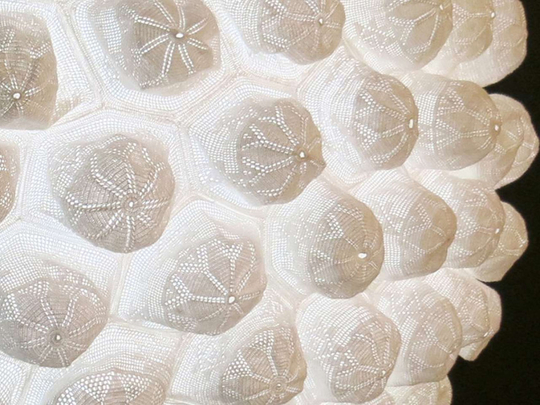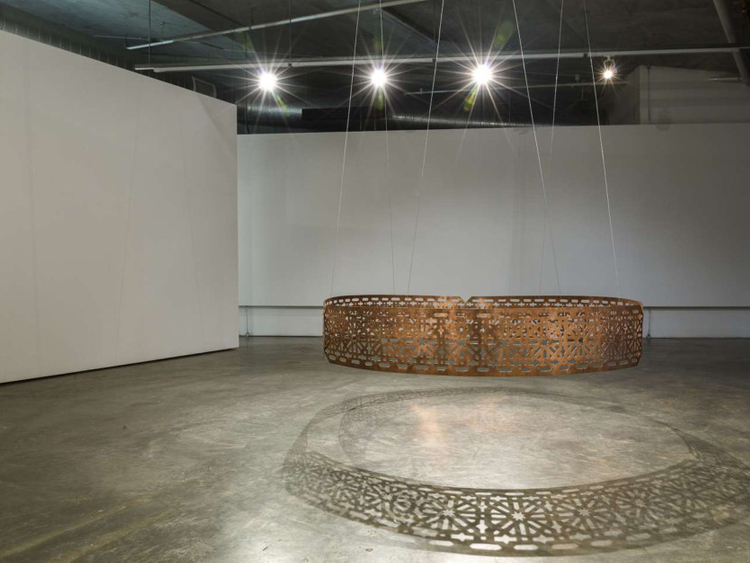
Light flashes upon 11 television screens the refugee artist and former hip-hop performer Khaled Sabsabi has arrayed in a circle on the floor. The formula for calculating the speed of light is printed nearby in five languages, including Arabic and English, acknowledging that diverging cultures share energy, space and time. If we could enter unseen realms, his work suggests, perhaps we could interact with angels.
Sabsabi’s works are showing at Adelaide’s ACE Open gallery along with 10 other Muslim artists, part of the Australian Muslim artist collective Eleven, that the Tripoli-born, Sydney-based Sabsabi initiated in 2016, inspired by the Indigenous Australian artist collective proppaNOW.
In this first major exhibition by the collective, Waqt al-Tagheer: Time of Change, the multidisciplinary artists reflect on migration, exile, social and political upheaval and spiritual epiphanies.
Sabsabi, 52, arrived in Australia in 1978 at age 12, his family fleeing Lebanon’s civil war. “All religions and faiths there caused atrocities,” he says. “The memories are still with me: bodies being brought in and the smell, and witnessing battles and going from shelter to shelter. It was only five years ago I found out what post-traumatic [stress] syndrome is, and I still suffer from that. That’s the importance of art, not just for poetics and aesthetics, but ... to heal and reconcile as well.”
His family settled in western Sydney, where Sabsabi was a disaffected teenager. “It was really white, and there was a lot of racism. The second day at school, someone picked a fight with me. I ended up getting punched in the head. I still don’t know why.”
The teenage Sabsabi identified with the black liberation struggles of the Black Panthers in the United States, and began performing hip-hop. He has found peace exploring Sufism, a Muslim form of mysticism, because, he says, it eschews dogma. Sufism guides his art.
Sabsabi started the collective with artists, from emerging to established, who are also members of what he calls “marginalised and isolated” communities. “I’ve always loved the idea of collectives, of unionism, and people coming together to find solutions,” he says. Without being prescriptive, he wanted the collective to address pre- and post-9/11 representations of Islam. While the established artists act as mentors, “the less-known artists keep us honest and inspired as well”, he says. Diversity of age, gender, ethnicity and different strands of faith have been key.
The age difference between brothers Abdul Abdullah, 31, and Abdul-Rahman Abdullah, 40, both raised in Perth, is starkly reflected in their respective artworks. Abdul was 15 when terrorists brought down the twin towers in New York on September 11, 2001, and he suffered from more suspicion, as a teenager, than Abdul-Rahman did. “The biggest difference between our approaches is he has a pre-9/11 mentality and I have a post-9/11 mentality,” says Abdul, who recalls his own outrage when his Malaysian-born mother’s head scarf was ripped from her head on a Perth street. “I see being Muslim as a political identity.”
Now based in Sydney, Abdul overtly confronts racism and Islamophobia in his work, wearing an ape mask in the photo Journey to the West because he is perceived as the “monstrous, threatening and villainous ‘other’.” Meanwhile, his brother’s painted wooden sculpture, 500 Books, recreates the romantic moment in 1988 when he uncovered 500 identical Sufi texts beneath a sheet in the family garage. The boys’ sixth-generation Australian father, who had converted to Islam, had saved the books from being pulped.
In Abdul Abdullah’s Wedding series, subjects wear balaclavas to signify “the projection of criminality on innocent bodies” — a shared experience of Muslims and, most recently, African migrant youth , targeted by both media and politicians.
“A lot of the African kids they’re targeting are Muslim anyway,” he says. “So there’s overlap. [But] for many people Muslims represent an existential threat ... the suspicion that that person has the mindset to kill people on a broad scale.”
On the far gallery wall, collective member and poet Eugenia Flynn’s text “With my sister” is printed in large letters, speaking of her watching footage of “light brown dust all over the people” while holding the “secret” of “me and al-Malik”, one of the 99 names of Allah in Islam. The poem reflects the simultaneous public horror of the 9/11 attacks and the already growing private spiritual realisation by Flynn, a Tiwi, Larrakia and Chinese woman, that she wanted to convert to Islam. The events are unrelated: “It was only years later I had a realisation of the timing,” she says.
Flynn saw converting to Islam as the opportunity to express her belief in the “oneness of God”. She is the youngest of four sisters growing up in Adelaide to a Catholic father and Buddhist mother. Flynn felt unable to accept the Catholic teaching of God in human form or the existence of a trinity. “My dad was happy someone else in his family was religious. Everyone is very supportive now, but at the time it was tough: when you have a close family, it can be challenging when someone does something that can seem quite foreign.”
The collective’s other works on display include a a circular pierced copper sculpture hanging from the gallery ceiling, called Musallah, by Shireen Taweel inspired by an old mosque in Broken Hill. Its exterior made of corrugated iron and interior lined with pressed tin, the mosque is situated at the site of a former camel camp, where Afghan and Indian camel drivers loaded and unloaded teams. Taweel’s interpretation might be seen as a metaphor for the Lebanese Muslim diaspora and its cultural contribution to Australia.
Taweel says the exhibition audience will come to understand the diversity of Muslims in Australia. “We have very different voices and come from very different perspectives,” she says. Showing art together has been emboldening for the artists who might otherwise feel vulnerable exhibiting alone: “Working with the collective gives a sense of connection and community. To share conversation and have that safety of openness has been great.”
Abdullah MI Syed’s Aura II consists of white crocheted prayer caps delicately hand-stitched together and placed over LED lights on the gallery wall, commenting on the “unity, beauty and infinite presence of the divine in Islam and its relation to nur (light)”. The work purposely resembles the moon, on which Syed would obsessively gaze as a child. At other times, Syed has drawn beards on non-Muslim men from magazine covers, never having dared to grow a beard himself outside of Pakistan for fear of attracting racial profiling. He is interested in showing that men can be empathic, feminine: “If I want to cry and show myself and hug someone, why wouldn’t I do that?”
Having first migrated to the United States before migrating to study and practice his art in Australia a decade ago, Syed brings to the collective a perspective that Islamophobia and the political far right is much more pronounced in the US, to which he often returns to visit family. “As Australians, we understand diversity probably more so than in America. As a minority, I feel more protected here.”
Working in a collective is attractive because art is part of a “global narrative”, says Syed, especially now given the Trump influence on Australia. “There are 11 members here, but each one comes from a different experience, practising or being raised as Muslim. That tells us a lot about what Islam is today. There are different sects — Sunni, Shiite and so on — and the collective has representation of them. It suggests Islam being not so monolithic; the Quran is there to guide what we need to practice, but at the same time it’s also about individual choice.”
–Guardian News & Media Ltd
Waqt al-tagheer: Time of Change is showing at ACE Open, Adelaide, until April 21.













